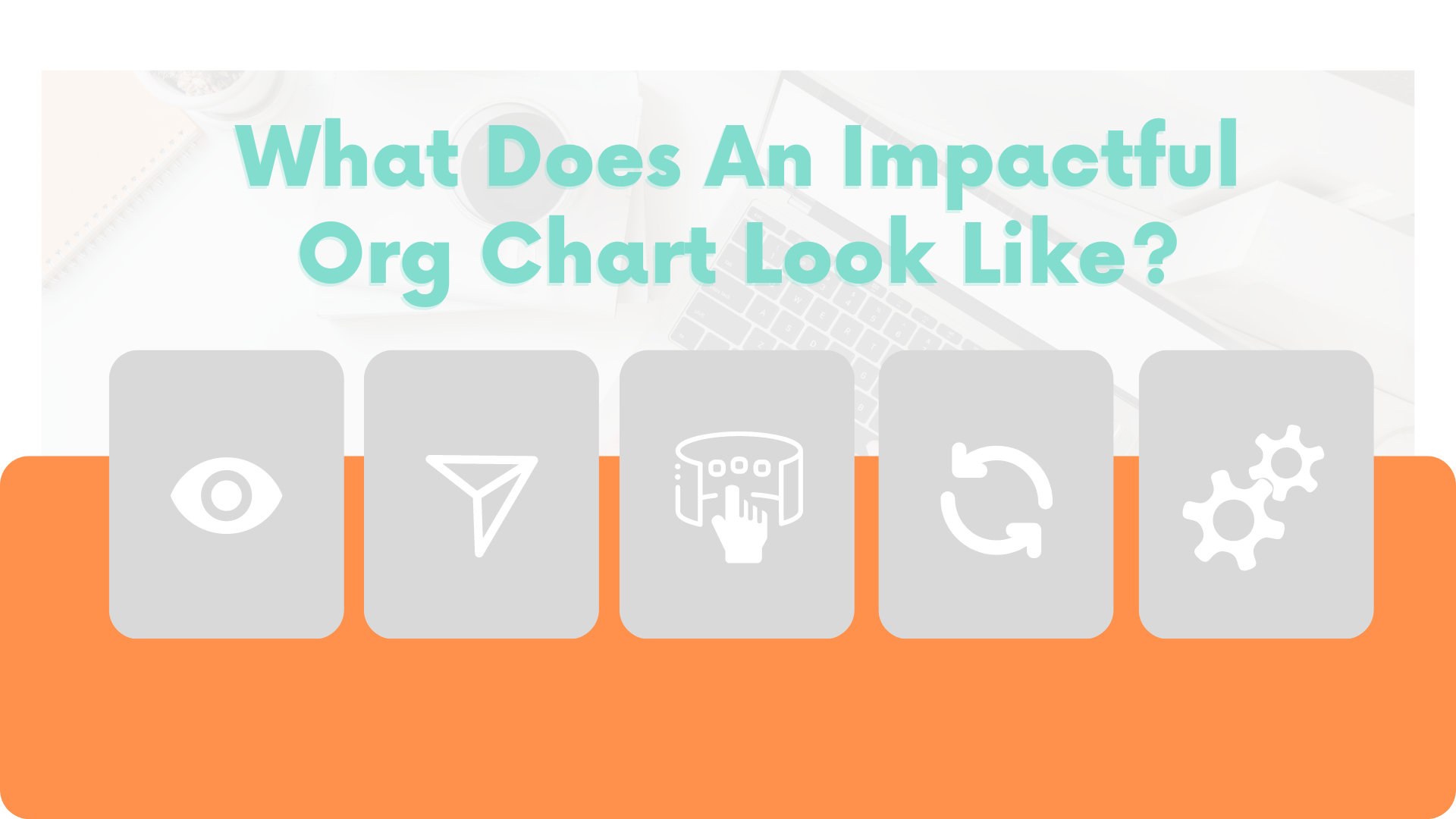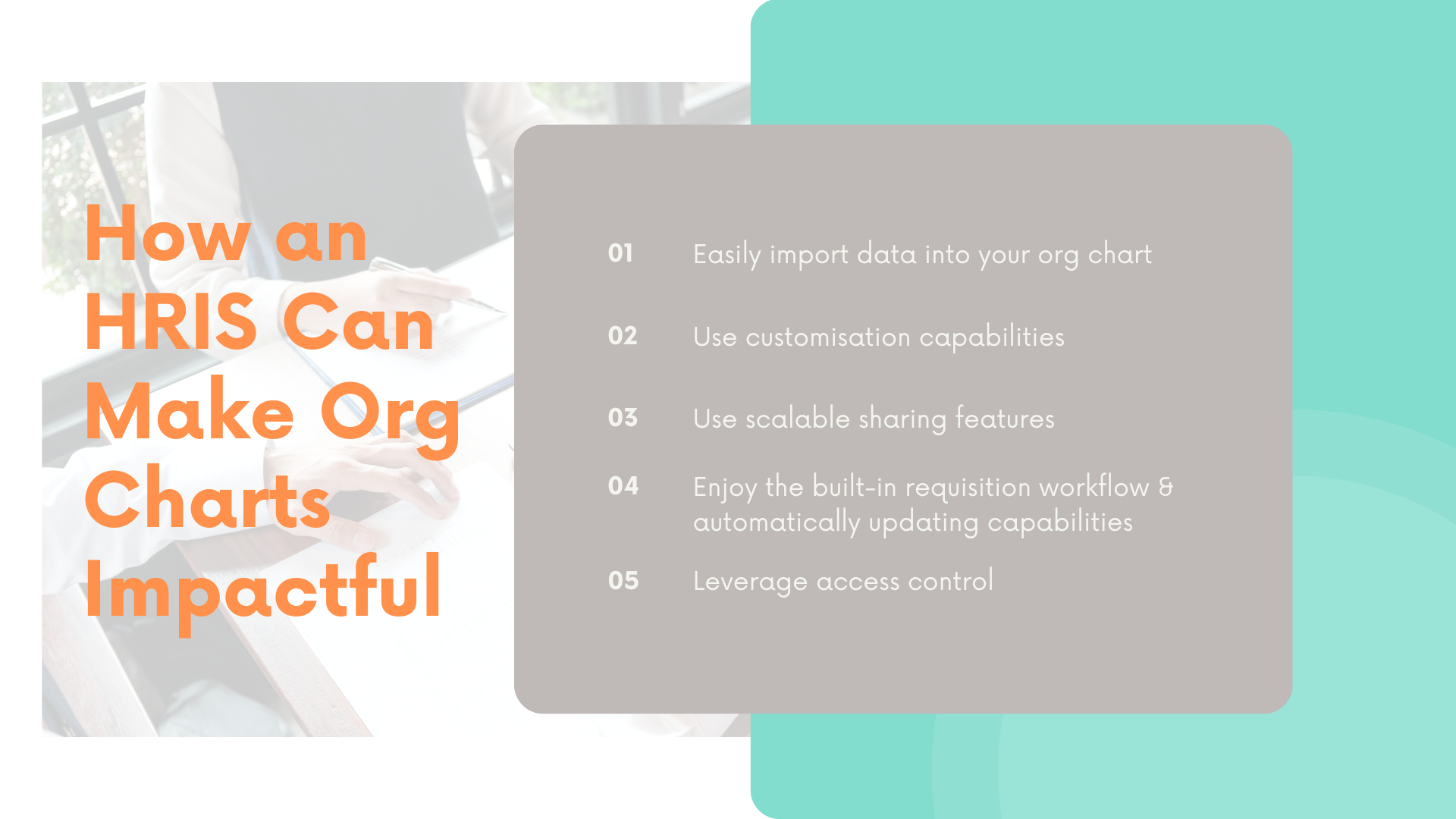Gone are the days of referring to bland and static diagrams as org charts. With an HRIS at your disposal, an org chart should be a dynamic tool that helps alleviate administrative burdens and makes HR tasks easier. In the first half of this blog, we will discuss what an impactful org chart looks like, and in the second half, we will explain how an HRIS can help you leverage one. If you’re curious about how to transform your org chart into a tool that truly makes a difference, then keep reading.
What Does An Impactful Org Chart Look Like?

An impactful org chart should be…
- A visual representation of all employees, their positions, and reporting lines
- Easy to share
- Highly functional & interactive
- Constantly up-to-date
- Allow for access control (who can do/see what)
These elements should make it easier for HR professionals and managers to do their jobs while eliminating those time-consuming administrative tasks.
Visual Representation of All Employees, Their Positions, and Reporting Lines
At first glance, your org chart should allow you to clearly understand your organisational hierarchy and reporting lines. It should allow the users to customise what position details, such as remuneration, FTE, etc., they would like to have surfaced on the individual nodes of the org chart. Another way that your org chart should add value is by allowing you to visualise all vacancies that are open for recruitment within your organisation. This will allow you to be more productive, identify gaps that need to be filled, and prioritise recruitment efforts.
Regardless of size, your org chart should be able to be viewed in different ways that best work with your organisation. Whether you want an outline of the entire organisational structure or to collapse certain sections for a more concise division-specific view, an impactful org chart should give you this freedom. Additionally, an org chart with colour coding and employee images would help distinguish departments and leaders, enhancing clarity and speeding up the retrieval of relevant information.
Easy to Share
An essential feature that all org charts should have are easy sharing capabilities. You should be able to effortlessly share your org chart with the necessary managers and executives, without having to send large files or confusing screenshots via email.
Highly Functional & Interactive
The benefits of an org chart should go beyond just its aesthetic appeal. You should be able to interact with it. Imagine having the ability to initiate and request approvals for crucial HR processes like recruitment, onboarding, offboarding, and change of conditions for employees directly from the org chart itself. This dynamic functionality would transform the org chart from a static diagram into a valuable tool that actively streamlines essential tasks.
Constantly Up-to-Date
Using an org chart with outdated position details or that fails to reflect current vacancies can lead to significant issues. It must be constantly filled with the most up-to-date information ensuring that HR, managers, and executives always have access to the most current and accurate version. Only then, will it be a worthwhile investment.
Allow for Access Control
To ensure data segregation and privacy, you must have full control over who can view and edit elements of your org chart. A truly useful org chart should allow you to customise access rights and restrict sensitive or confidential information within each node. This also applies when sharing the org chart. Whether you are sharing just a portion of it or the entire thing, it is crucial to ensure that only the employee names and their respective positions are surfaced on individual nodes of the org chart no matter what level of customisations you may have configured for the normal users and HR.
How an HRIS Can Make Org Charts Impactful

In this section, we will outline 5 ways an HRIS can facilitate the components discussed above, and ultimately help you employ an impactful org chart for your organisation.
1. Easily Import Data
To start creating your impactful org chart, use an HRIS to effortlessly import your position and employee data into the org chart. You can import details ranging from the basics of position names and reporting lines, all the way to remuneration data. The automatic sorting process of an HRIS, spares you the tedious task of manual data entry and lets you say goodbye to potential errors that often accompany it.
2. Use Customisation Capabilities
Use enterprise-grade HRIS features to customise your org chart to meet the unique needs of your organisation. With info surfacing capabilities, you can display position and employee details that your organisation deems important on your org chart. For example, if you find that employee pronouns are important to show in an org chart, you can add it as a custom field to display on all nodes.
Additionally, you can easily add to or create new reporting lines, and differentiate them with formatting options. For instance, you could use this feature to segment your org chart by department. Easy colour coding capabilities can help you differentiate the marketing department, from the sales department, from the customer service department, and so on. This would contribute to the clear visualisation of your organisational structure to make your org chart more effective. You could also make your org chart more specific to your organisation by adding headshots of each employee to their corresponding positions, enhancing clarity and bringing personality to your org chart.
3. Use Scalable Sharing Features
Regardless of the size of your organisation, HRIS accounts for scalability when sharing your org chart. Use it to easily grab a link from your org chart platform and share it with whoever needs access. As the link will take you straight to the platform, any modifications made to the org chart will be updated in real-time, ensuring uninterrupted access to the most up-to-date version.
4. Enjoy the Built-In Requisition Workflow & Automatically Up-to-Date Capabilities
Streamline HR tasks by making use of your org chart’s built-in requisition workflow and live updating capabilities. As certain HR software such as Martian Logic’s allow you to initiate employment-related processes directly from the org chart, you can trust that all information is up-to-date and reliable at all times.
For example, let’s say you want to launch a request-to-hire for a senior travel consultant position at your establishment. Your HRIS should let you click into that vacancy node on your org chart, request approval, and start recruiting for that position. Once you decide on a candidate for that position, all that new hire needs to do is complete their onboarding pack and they’ll be automatically populated into the org chart. This also applies to changes of conditions and offboarding of current employees. Without the need to go in and manually make adjustments every time a change occurs, you can trust that your org chart stays organically up-to-date at all times. HR, managers, and executives will always have access to the most current and accurate position information.
5. Leverage Access Control
With HRIS, you can grant the authority to customise and regulate the visibility, accessibility, and permissions to the org chart. Some platforms such as Martian Logic’s maintain that each account only has one owner. That owner can selectively authorise admins to access the sensitive information within each node on the org chart. It also ensures that when you share an org chart via a share link, only the position name and assigned employee are displayed on the node. This upholds confidentiality and protects classified employee information.

